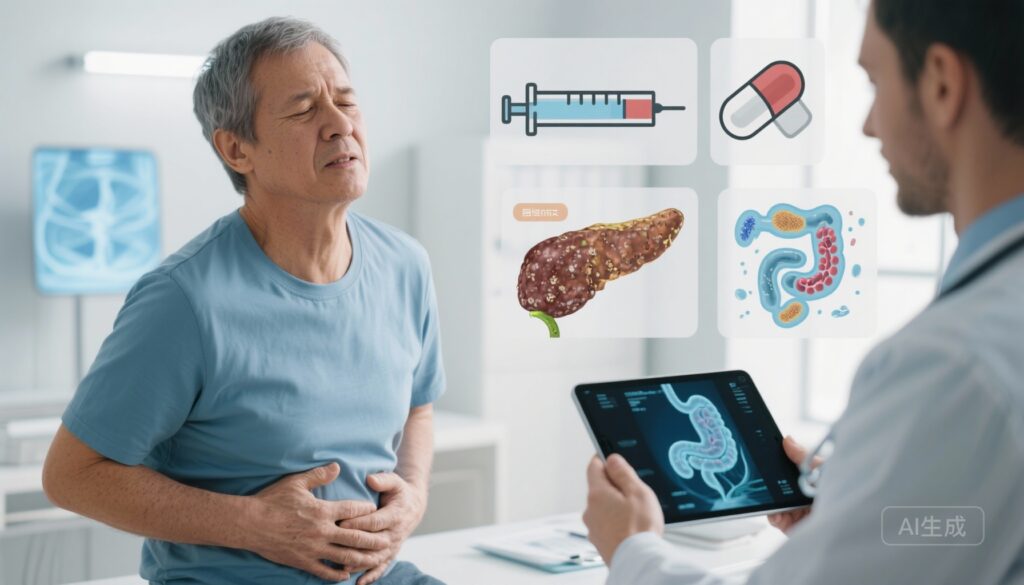Highlight
– Type 3c diabetes (T3cDM) secondary to chronic pancreatitis (CP) arises from combined exocrine and endocrine pancreatic failure—distinct from type 1 and type 2 diabetes in mechanism and clinical behavior.
– Key pathogenic drivers include progressive islet loss and secretory failure, exocrine insufficiency with impaired nutrient and incretin signaling, pancreatic polypeptide (PP) deficiency, hepatic insulin resistance, and likely contributions from systemic inflammation and gut microbial dysbiosis.
– Diagnosis relies on standard diabetes criteria plus clinical markers of pancreatic disease (history of pancreatitis, steatorrhea, imaging, low fecal elastase) and functional tests (reduced PP response to mixed meal) that help distinguish T3cDM from T1DM and T2DM.
– Management emphasizes alcohol and smoking cessation, pancreatic enzyme replacement therapy (PERT) and nutritional support, cautious use of metformin for mild disease, and insulin therapy for advanced or unstable diabetes. Incretin-based and insulin-sensitizing agents remain experimental or not routinely recommended; targeted strategies (PP therapy, microbiome modulation) are investigational.
Background and disease burden
Chronic pancreatitis (CP) is a progressive inflammatory and fibrotic disorder of the pancreas that compromises both exocrine and endocrine function. When pancreatic disease causes diabetes, it is categorized as diabetes of the exocrine pancreas, also called type 3c diabetes mellitus (T3cDM or pancreatogenic diabetes). Although T3cDM is much less prevalent than type 2 diabetes in most populations, it has distinct pathophysiology, greater risk of malnutrition and brittle glycemic control, and is frequently misclassified as T1DM or T2DM. Contemporary studies estimate that T3cDM accounts for up to 5–10% of diabetes in Western cohorts, with chronic pancreatitis being the single most common cause among pancreatic diseases.
The clinical burden of T3cDM extends beyond hyperglycemia: patients often have exocrine pancreatic insufficiency (EPI), fat-soluble vitamin deficiencies, osteoporosis, weight loss, and increased morbidity from pain and repeated hospitalizations for pancreatitis. Misclassification leads to inappropriate therapies (e.g., oral agents alone without addressing EPI) and delayed recognition of hypoglycemia risk from impaired counter-regulation.
Study design and scope of evidence reviewed
This narrative synthesis integrates the recent focused review by Rasheed et al. (Pancreatology, 2025) with established clinical guidance and mechanistic data up to mid-2024. Evidence sources include pathophysiological studies (human and animal), clinical cohort analyses of CP populations, diagnostic evaluation studies (fecal elastase, hormonal tests), and interventional reports (PERT, surgical interventions, and medical therapy case series). The literature comprises observational cohorts, mechanistic translational work, small randomized or nonrandomized trials, and expert consensus; randomized data specific to T3cDM management remain sparse.
Key findings: mechanisms linking chronic pancreatitis to diabetes
1. Loss of islet mass and insulin secretory capacity
The dominant mechanism of T3cDM is progressive loss of pancreatic islet cells due to chronic inflammation, fibrosis, and repeated injury. Histological studies of CP show reduced beta-cell mass and disrupted islet architecture. Clinically, this manifests as impaired first- and second-phase insulin secretion and progressive insulinopenia that predisposes to hyperglycemia and frequent need for insulin replacement as disease advances.
2. Alpha-cell dysfunction and impaired counter-regulation
Alpha-cell dysfunction in CP leads to blunted glucagon responses during hypoglycemia. Combined beta-cell failure and impaired glucagon-mediated counter-regulation increase the risk of severe and unpredictable hypoglycemia, especially with exogenous insulin therapy. This brittle glycemia distinguishes T3cDM from typical T2DM and requires careful insulin titration and patient education.
3. Exocrine pancreatic insufficiency, nutrient malabsorption, and the incretin axis
Exocrine insufficiency (reduced lipase and amylase delivery to the intestine) causes maldigestion and malabsorption of fats and fat-soluble vitamins. EPI alters the nutrient composition reaching the distal small intestine, which can reduce secretion of incretin hormones (GLP-1 and GIP) and may blunt postprandial insulin secretion—contributing to a reduced incretin effect. Several clinical studies and mechanistic experiments suggest that pancreatic enzyme replacement therapy (PERT) can partly restore incretin responses and improve postprandial glycemia in patients with CP and EPI.
4. Pancreatic polypeptide deficiency
Pancreatic polypeptide (PP), secreted by PP cells within the islets and head of the pancreas, modulates hepatic glucose production and satiety signals. CP frequently impairs PP secretion; a reduced PP response to a mixed meal test can help differentiate T3cDM from T1DM and T2DM. Restoring PP signaling has been proposed as a therapeutic avenue, with small studies suggesting metabolic benefits of PP infusion, but clinical application remains investigational.
5. Hepatic and peripheral insulin resistance
Unlike the pure insulinopenia of type 1 diabetes, many patients with T3cDM exhibit varying degrees of hepatic insulin resistance—possibly related to intrahepatic lipid changes, systemic inflammation, and altered gut–liver signaling. Peripheral insulin resistance (skeletal muscle) has been less consistently demonstrated; sarcopenia and reduced physical activity in CP may exacerbate peripheral insulin resistance in some patients. The relative contribution of hepatic versus peripheral insulin resistance likely varies by patient phenotype (alcohol-related CP, metabolic risk factors, nutritional status).
6. Gut microbiome dysbiosis and systemic inflammation
Emerging data implicate gut microbial changes in CP that could influence glucose metabolism through altered bile acid signaling, endotoxemia, and modulation of incretins. While causality remains to be proven, microbiome-targeted approaches (probiotics, prebiotics, fecal microbial transplant) are under investigation as adjunctive strategies in this population.
Diagnosis: distinguishing T3cDM from other diabetes types
Diagnosis of diabetes in CP follows prevailing glycemic thresholds (fasting glucose, HbA1c, OGTT) per ADA criteria. The clinical challenge is to classify diabetes as pancreatogenic. Key diagnostic clues favoring T3cDM:
– Clinical history of chronic pancreatitis, recurrent acute pancreatitis, pancreatic surgery, pancreatic calcifications or ductal changes on imaging.
– Evidence of EPI: steatorrhea, weight loss, low fecal elastase (<200 µg/g), malabsorption of fat-soluble vitamins.
– Absence of autoimmune markers typical for type 1 diabetes (negative GAD, IA-2 antibodies) in a patient with insulin deficiency.
– Low or absent pancreatic polypeptide response to a standardized mixed-meal test (used in specialized centers) helps discriminate T3cDM from T1DM and T2DM.
Practical approach: screen patients with CP for diabetes annually (fasting glucose, HbA1c; consider OGTT if suspicion high). Test for EPI (fecal elastase) and perform imaging to document structural disease. When classification is unclear, refer to endocrinology and consider specialized testing (mixed-meal PP response).
Treatment principles and therapeutic options
Management must address three intertwined problems: hyperglycemia, exocrine insufficiency/nutritional deficits, and pancreatitis-related morbidity.
General measures
– Abstinence from alcohol and smoking is fundamental.
– Nutritional assessment and correction of deficiencies (vitamins A, D, E, K, calcium) and individualized caloric/protein intake plans.
– Pain management and treatment of complications of CP.
Pancreatic enzyme replacement therapy (PERT)
PERT is central to treating EPI and has metabolic benefits beyond alleviating steatorrhea. By improving digestion and nutrient delivery to the gut, PERT can increase incretin responses and improve postprandial glucose stability. Clinically, PERT often enables weight stabilization and better glycemic control in patients with coexistent EPI and diabetes. Dosing should be individualized and taken with meals; monitor symptom response and nutritional parameters.
Antihyperglycemic pharmacotherapy
Therapeutic choice in T3cDM differs from T2DM because of insulin deficiency, malnutrition, and hypoglycemia risk.
– Metformin: often recommended as first-line for patients with mild, uncomplicated T3cDM and preserved weight, due to modest insulin-sensitizing effects and potential benefit on hepatic insulin resistance. Caution: weigh against gastrointestinal intolerance and malnutrition.
– Insulin secretagogues (sulfonylureas, meglitinides): generally discouraged because progressive insulin deficiency makes their benefit limited and increases hypoglycemia risk.
– Insulin sensitizers (thiazolidinediones): rarely used due to fluid retention, fracture risk, and uncertain benefit in T3cDM.
– Incretin-based therapies (DPP-4 inhibitors, GLP-1 receptor agonists): currently not routinely recommended for T3cDM; clinical data are limited and CP patients historically were excluded from major trials. Safety concerns about pancreatitis risk have led to caution, though contemporary evidence has not clearly established a causal pancreatitis signal for these agents in general populations; targeted trials in T3cDM are needed.
– SGLT2 inhibitors: no robust data in T3cDM; risk of euglycemic ketoacidosis in the setting of low insulin reserve and malnutrition suggests prudence.
– Insulin therapy: the mainstay for moderate to severe T3cDM or when glycemic control is inadequate. A basal-bolus approach is commonly used, titrated carefully to minimize hypoglycemia. Education on sick-day rules and glucose monitoring is essential given the impaired counter-regulatory response.
Surgical and advanced interventions
– Pancreatic resection or drainage procedures for CP-related complications can alter glucose trajectories; post-surgical diabetes sometimes worsens due to further islet loss.
– Total pancreatectomy with islet autotransplantation (TPIAT) is an option for selected patients with intractable pain and CP; it can reduce pain and preserve some endocrine function but requires multidisciplinary evaluation.
Safety considerations and monitoring
– Frequent hypoglycemia surveillance is important owing to alpha-cell dysfunction.
– Regular monitoring of nutritional status, bone health, and fat-soluble vitamin levels.
– Screen for complications of diabetes (retinopathy, nephropathy) per standard schedules.
Emerging and experimental approaches
– Pancreatic polypeptide therapy: early-phase studies suggest metabolic benefits; clinical application awaits larger trials.
– Microbiome modulation: targeted manipulation of gut microbiota to restore incretin signaling and reduce systemic inflammation is an active research area.
– Metabolomics for risk stratification: metabolome-based models to predict progression from prediabetes to T3cDM have potential but require validation.
– Randomized trials of PERT specifically powered for glycemic outcomes are needed.
Expert commentary and interpretation
T3cDM is an underrecognized but clinically important form of diabetes. Its heterogeneous pathophysiology—combining insulin deficiency with variable insulin resistance and exocrine failure—demands a distinct clinical approach. Important practical points for clinicians include: (1) actively screen patients with CP for diabetes and EPI, (2) prioritize PERT and nutritional rehabilitation as a component of metabolic control, and (3) adopt individualized pharmacotherapy with a low threshold for insulin initiation while avoiding therapies with uncertain benefit or safety in this population.
Current guidelines and expert reviews emphasize the diagnostic challenge and propose pragmatic algorithms, but they also highlight the paucity of high-quality randomized evidence to inform drug-specific recommendations. This gap creates opportunities for translational and clinical research linking mechanistic biomarkers (PP response, fecal elastase, metabolomics, microbiome signatures) to treatment response.
Limitations and research gaps
– Lack of large randomized controlled trials evaluating glucose-lowering agents specifically in T3cDM.
– Need for validated, widely available diagnostic tests that reliably distinguish T3cDM from T1DM and T2DM in routine practice.
– Unclear long-term safety and efficacy of incretin-based agents in patients with CP.
– Mechanistic uncertainty about the exact contributions of peripheral insulin resistance and gut microbiome changes.
Conclusion
Type 3c diabetes associated with chronic pancreatitis is a distinct clinical entity characterized by progressive islet loss, exocrine insufficiency, altered incretin signaling, and variable insulin resistance. Optimal care requires integrated management of pancreatic exocrine disease, nutritional deficits, and tailored glycemic therapy—with PERT and, when necessary, insulin as central pillars. Greater clinician awareness, systematic screening of at-risk patients, and research priorities that include randomized trials, biomarker validation, and microbiome-directed interventions will improve outcomes for this underserved subgroup of people with diabetes.
Funding and clinicaltrials.gov
No specific industry funding is reported in this narrative synthesis. Clinicians and researchers seeking trial information on interventions for T3cDM or chronic pancreatitis can search clinicaltrials.gov using terms such as “pancreatogenic diabetes,” “chronic pancreatitis,” “pancreatic enzyme replacement therapy,” and “islet autotransplantation.”
References
– Rasheed A, Galande S, Farheen S, Mitnala S, Nageshwar Reddy D, Talukdar R. Type 3c diabetes associated with chronic pancreatitis: A narrative review. Pancreatology. 2025 Nov;25(7):1003-1012. doi: 10.1016/j.pan.2025.08.005. Epub 2025 Aug 9. PMID: 40819996.
– American Diabetes Association. Standards of Care in Diabetes—2024. Diabetes Care. 2024. (Clinical practice guidance on classification and diagnosis of diabetes, including other specific types.)
(Readers requiring a fuller bibliographic list and specific trial citations are encouraged to contact the author or consult the source literature, including systematic reviews and guideline documents on diabetes secondary to pancreatic disease.)



